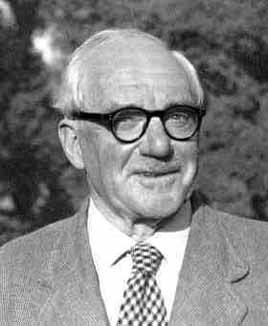John Edensor Littlewood facts for kids
Quick facts for kids
John E. Littlewood
|
|
|---|---|
 |
|
| Born |
John Edensor Littlewood
9 June 1885 |
| Died | 6 September 1977 (aged 92) Cambridge, England
|
| Alma mater | Trinity College, Cambridge |
| Known for | Mathematical analysis |
| Awards |
|
| Scientific career | |
| Fields | Mathematician |
| Institutions | Trinity College, Cambridge |
| Doctoral advisor | Ernest Barnes |
| Doctoral students |
|
John Edensor Littlewood (born June 9, 1885 – died September 6, 1977) was a very important British mathematician. He worked on many different areas of math, like analysis, number theory, and differential equations. He is also famous for working closely with other mathematicians, especially G. H. Hardy and Mary Cartwright.
Contents
Life Story
John Littlewood was born in Rochester, Kent, England, on June 9, 1885. He was the oldest child of Edward Thornton Littlewood and Sylvia Maud.
In 1892, when John was seven, his father became a headmaster at a school in Wynberg, Cape Town, South Africa. So, the whole family moved there.
John came back to Britain in 1900. He went to St Paul's School in London. There, he studied with a famous math teacher named Francis Sowerby Macaulay.
University and Early Career
In 1903, John Littlewood started studying at the University of Cambridge. He went to Trinity College. For his first two years, he prepared for the "Tripos" exams. These exams helped students get their first university degree. In 1905, he got the highest score in one part of the Tripos, which made him a "Senior Wrangler."
After finishing more exams in 1906, he began his research. His teacher, Ernest Barnes, suggested he try to prove the Riemann hypothesis. This is a very famous and difficult math problem. Littlewood didn't solve it completely, but he showed how it connected to another important idea called the prime number theorem. This work helped him become a Fellow of Trinity College in 1908.
From 1907 to 1910, he worked as a lecturer at the University of Manchester. Then, in October 1910, he returned to Cambridge. He stayed there for the rest of his career. In 1928, he became the Rouse Ball Professor of Mathematics. He retired from this role in 1950.
Awards and Recognition
John Littlewood received many important awards for his work. He became a Fellow of the Royal Society in 1916. This is a very high honor for scientists in Britain.
He also won:
- The Royal Medal in 1929
- The Sylvester Medal in 1943
- The Copley Medal in 1958
He was also the president of the London Mathematical Society from 1941 to 1943. He received the De Morgan Medal in 1938 and the Senior Berwick Prize in 1960.
John Littlewood passed away on September 6, 1977.
His Math Work
Most of John Littlewood's work was in mathematical analysis. This is a branch of math that deals with things like limits, derivatives, and integrals.
Key Discoveries and Ideas
When he first started research, his teacher asked him to work on the Riemann hypothesis. Littlewood found that if the Riemann hypothesis was true, then the prime number theorem would also be true. This was a big discovery for him.
He also came up with something called Littlewood's law. This idea suggests that unusual or "miraculous" events are actually quite likely to happen to people about once a month. It's a way of looking at how often rare things can occur by chance.
Littlewood continued to write math papers even when he was in his eighties. He worked on areas that later became known as dynamical systems. This field studies how systems change over time.
He also wrote a book of his memories called A Mathematician's Miscellany. It was published again in 1986.
Working with Others
Littlewood had many students who went on to become famous mathematicians themselves. Some of his PhD students included Sarvadaman Chowla, Harold Davenport, and Donald C. Spencer.
He often worked with other mathematicians by sending letters back and forth. He collaborated with Raymond Paley on something called Littlewood–Paley theory. This is important in Fourier theory, which helps break down complex signals into simpler ones. He also worked with Cyril Offord on problems involving random sums.
Littlewood also worked with Mary Cartwright on problems related to differential equations. These problems came from early research on radar. Their work helped create the modern theory of dynamical systems.
Working with G. H. Hardy
John Littlewood had a very long and important partnership with another famous mathematician, G. H. Hardy. They worked together for many years.
Together, they came up with ideas like the first Hardy–Littlewood conjecture. This is a strong idea about twin prime numbers, which are pairs of prime numbers that are very close to each other (like 3 and 5, or 11 and 13). They also developed the second Hardy–Littlewood conjecture.
Hardy and Littlewood also played a huge role in recognizing the amazing talent of an Indian mathematician named Srinivasa Ramanujan. Ramanujan taught himself math and was a true genius. Hardy and Littlewood helped him travel to the UK and work at Cambridge. Ramanujan later became a Fellow of the Royal Society and was seen as one of the greatest mathematicians ever, like Euler.
A Danish mathematician named Harald Bohr once joked about how important Hardy and Littlewood were. He said, "Nowadays, there are only three really great English mathematicians: Hardy, Littlewood, and Hardy–Littlewood." This shows how closely their work was connected.
There's a funny story about Littlewood. At a conference, a German mathematician told him he was surprised Littlewood was a real person! The German mathematician thought "Littlewood" was just a name Hardy used for his less important work. Littlewood found this very amusing.
See also
 In Spanish: John Edensor Littlewood para niños
In Spanish: John Edensor Littlewood para niños

